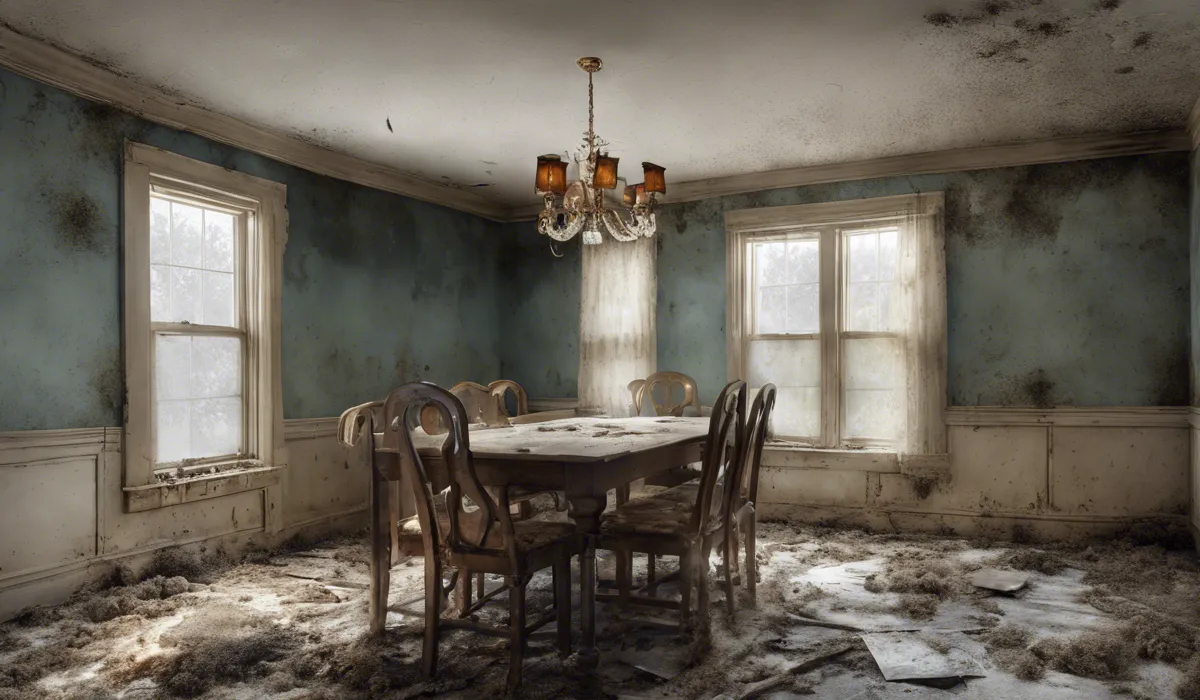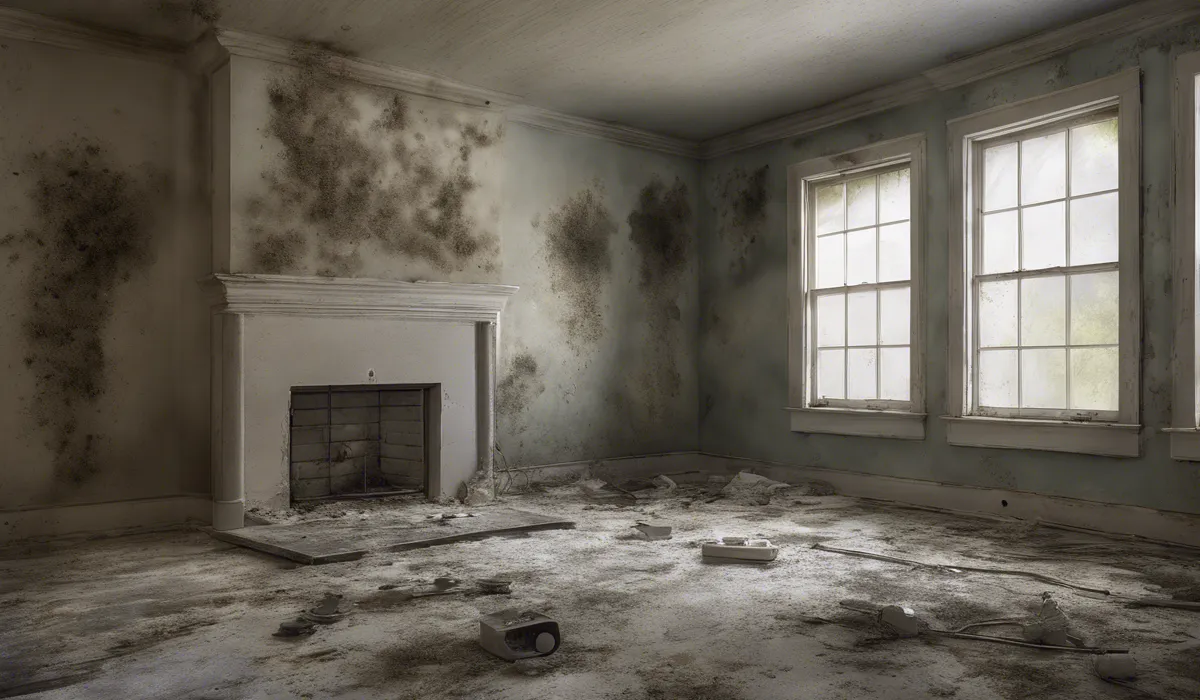Living in a house with mold poses health risks, especially for those with allergies or respiratory issues. It is crucial to address and remedy mold infestations promptly. While short-term exposure might be manageable for some, long-term residence in a mold-infested home is inadvisable.
Understanding Mold and Its Health Implications

Types of Mold Commonly Found in Homes
Mold is a type of fungus that thrives in moist environments and can be found in various forms within homes.
Some common household molds include Aspergillus, which often lives on food and in air conditioning systems, and Cladosporium, which can grow on fabrics and wood surfaces.
Another well-known type is Stachybotrys, commonly called black mold, which can grow on materials with high cellulose content, such as paper, wood, and gypsum board, when they become damp or water-damaged.
Understanding the types of mold is crucial in identifying and addressing them properly.
Health Risks Associated with Mold Exposure
Exposure to mold can lead to a variety of health issues, especially when individuals are exposed over a prolonged period.
Respiratory problems are the most common, with symptoms ranging from coughing and wheezing to severe allergic reactions. Some people may experience skin irritation, red eyes, or a runny nose.
In more severe cases, individuals with compromised immune systems or chronic lung illnesses may develop serious infections.
Vulnerable Populations and Symptoms to Watch For
While mold can affect anyone, certain groups are more vulnerable, including infants, the elderly, and those with pre-existing health conditions such as asthma or immune suppression.
Symptoms to watch for include persistent coughing, difficulty breathing, nasal congestion, and in some cases, heightened asthma symptoms.
It’s important for these populations to be especially mindful and to seek medical advice if they suspect mold-related health issues.
Long-Term Effects of Living in a Moldy Environment
Living in a home with mold can result in chronic health problems if not addressed. Long-term exposure can lead to respiratory infections, chronic sinusitis, and in some cases, may contribute to the development of asthma in children.
Mental health can also be affected, with some studies suggesting a link between mold exposure and depression. The risks underscore why it is crucial to ensure living environments remain mold-free.
Assessing Mold Infestation in Your Home

Recognizing Signs of Mold Growth
Identifying mold can sometimes be straightforward, especially when it’s visible as black or greenish spots on walls or ceilings.
A musty smell is another telltale sign of mold presence. However, mold can also be hidden behind wallpaper, in ceiling tiles, or within HVAC systems, so be aware of allergic symptoms that might indicate hidden mold.
Common Areas Where Mold Thrives
Mold loves damp, warm, and humid spaces, making bathrooms, kitchens, and basements common hotspots.
Areas around plumbing leaks, windows where condensation builds up, and any place that has experienced flooding are especially prone to mold growth.
Professional Mold Inspection and Testing
In cases where mold is suspected but not visible, a professional mold inspection can be invaluable.
Professionals use specialized equipment to detect hidden mold and assess the extent of an infestation. Testing can then determine the type of mold and the appropriate removal strategies.
DIY Mold Detection Methods
For those who prefer the DIY route, home testing kits are available. These kits typically involve taking samples from surfaces or the air and sending them to a lab for analysis.
While helpful, these kits are not as comprehensive as a professional inspection and should be used as a preliminary measure.
Remediation and Prevention Strategies

Steps to Effectively Remove Mold
Removing mold starts with addressing the moisture problem that allowed the mold to grow.
Once the source of moisture is fixed, hard surfaces can be cleaned with detergent and water.
Porous materials like ceiling tiles and carpet may need to be discarded if they’re moldy. After cleaning, it’s crucial to dry the area thoroughly to prevent the mold from returning.
Hiring Professional Mold Remediation Services
For extensive mold problems, professional remediation services are recommended. These experts have the equipment and expertise to safely and effectively remove mold from your home, ensuring that it’s done correctly and thoroughly.
They also have the tools to prevent mold spores from spreading to other areas during the removal process.
Preventative Measures to Keep Mold at Bay
Prevention is key when it comes to mold. Maintain a low indoor humidity level, ideally between 30-50%, by using dehumidifiers and air conditioners. Ensure proper ventilation in high-moisture areas and fix leaks immediately.
Use mold-resistant products in your home construction or renovation projects to reduce the risk of mold growth.
Maintaining a Mold-Free Living Environment
Regular maintenance is essential for keeping your home mold-free. This includes cleaning and drying any damp areas promptly, ensuring good air circulation, and routinely checking for signs of mold.
Educate yourself on mold-resistant materials and consider integrating them into your home, especially if you live in a high-humidity area or a region prone to flooding.
FAQs About Living in a House with Mold
Is it safe to live in a house with mold?
While short-term exposure might be manageable for some individuals, living in a house with mold, especially over the long term, is not considered safe and poses health risks, particularly for those with allergies or respiratory problems.
What health issues can mold in the home cause?
Mold can cause various health issues including allergic reactions, asthma attacks, respiratory infections, and potentially worsen pre-existing health conditions.
How quickly should mold be removed from a home?
Mold should be addressed and remedied as quickly as possible to minimize health risks and prevent further spread.
Can some people live in a house with mold without getting sick?
Some individuals may not immediately experience symptoms, but no one is immune to the potential health risks of mold exposure, and it can still have long-term effects on health.
Is short-term exposure to mold as dangerous as long-term exposure?
Short-term exposure to mold is typically less dangerous than long-term exposure, but even short-term exposure can be harmful to sensitive individuals, such as those with mold allergies or asthma.
Final Thoughts
Living in a home with mold carries significant health risks, particularly for individuals with allergies or respiratory conditions. Prompt action is essential to tackle mold issues. While some may tolerate short-term exposure, residing long-term in a moldy environment is strongly discouraged due to the potential health hazards.
